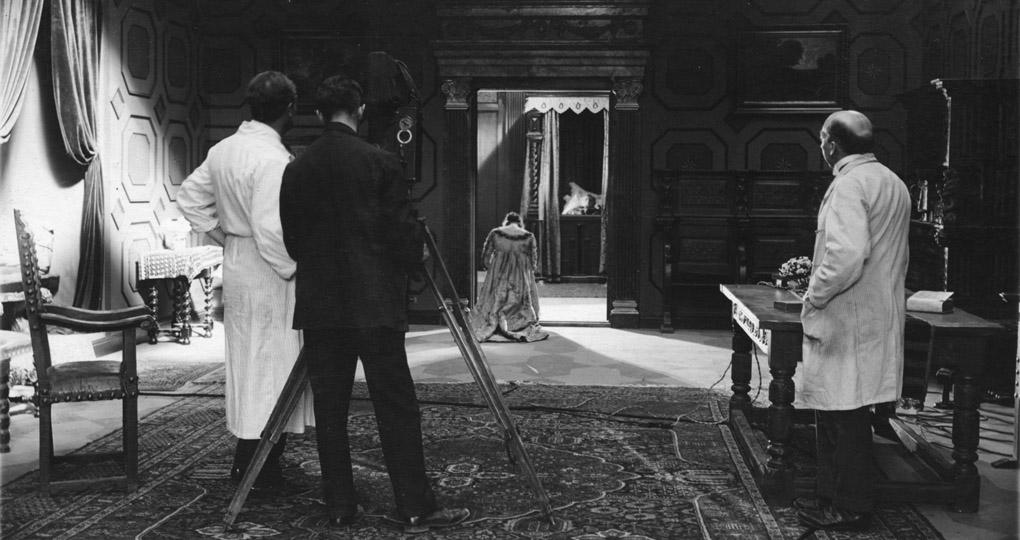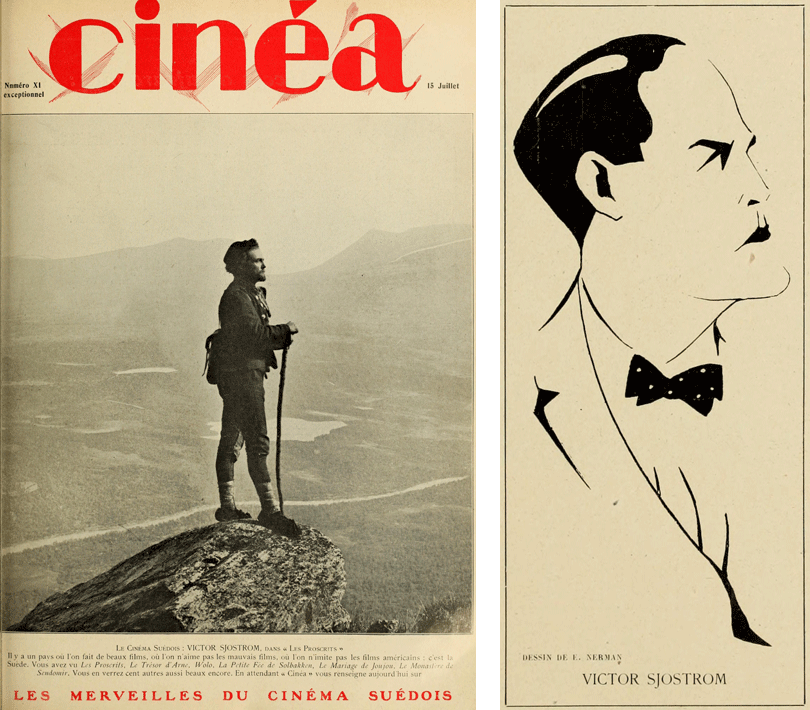
Sjöström and the Swedish Invasion
When Vem dömer hit the silver screen in 1922, Swedish cinema was in the middle of a cinematic Golden Age led by Victor Sjöström, Mauritz Stiller, and the production company they worked for, Charles Magnusson’s AB Svenska Biografteatern (also known as Svenska Bio and Swedish Biograph, for more cf. Fullerton 2005: 890-891)1; this Golden Age was kicked off by Terje Vigen (A Man There Was; Victor Sjöström, 1917) and ended with the exodus of Victor Sjöström, Mauritz Stiller, and star actors Lars Hanson and Greta Garbo, who were drawn to Hollywood in 1923 and 1924 (Marklund 2010: 72-75). Vem dömer was released internationally as Mortal Clay and Love’s Crucible and became part and parcel of a Swedish invasion that had been widely reported on since at least 1919, when Sjöström led the way with Tösen från Stormyrtorpet (The Girl from the Marsh Croft; 1917), which was released to great enthusiasm in the United States to become “the first photoplay of importance to come over” from a country that has “more telephones per capita than any other” (Anon. 1, 1919: 32) and “the first Swedish photoplay to be shown in New York City” where its “many beautiful scenes [and] splendid acting” were celebrated with applause at its Carnegie Hall screening, according to D.W. Griffith’s spouse (Griffith 1919: 6-7). This article will consider the international significance of Vem dömer, arguing that it has academically been overlooked within the oeuvre of Victor Sjöström and as the key part of the Swedish Golden Age that it is. It will do so by analyzing the film’s key tropes and stylistic markers, focusing on the self-reflexive thematization of art via the distribution through Little Theatre Films, the characterization of artist and model, and its representation of the Sacred Image; the circularity of the narrative through motifs, gestures, and tableaux; and the film’s rejuvenation of the Old Masters through the use of space, light, and the “Scandinavian dissolve.”

The wonders of the Swedish cinema in general, and of Sjöström in particular, had first been sung by the French, since Gaumont distributed Svenska Bio’s films and Impressionist filmmaker Louis Delluc devoted an entire issue of his film magazine, Cinéa, to the talents of Swedish directors in 1921. The cover of the magazine (figure 1) is graced with an image of Victor Sjöström standing on top of a mountain as escaped thief Berg-Ejvind in Berg-Ejvind och hans hustru (The Outlaw and His Wife; Victor Sjöström, 1918), accompanied by the announcement that “there is a country where they make beautiful films, where they don’t like bad films, where they don’t imitate American films: it is Sweden” (Anon. 2, 1921: cover). The issue describes the merits of a handpicked selection of 29 films “to review and to view” from Balettprimadonnan (Wolo Czawienko; Mauritz Stiller, 1916) to Körkarlen(The Phantom Carriage; Victor Sjöström, 1921) (Anon. 3, 1921: 5), almost all of them films that are now (or should be) considered a part of the pantheon of early Swedish cinema. Though Vem dömerhad yet to be released, the issue does provide illustrated caricatures of its principals: director Victor Sjöström (figure 2), lead actress Jenny Hasselqvist (figure 3), and male lead Gösta Ekman (figure 4). Sjöström is the only figure to get a full-page spread that emphasizes the success of his films in France, Germany, and the U.K., and that paints the director as a Swedish national poet “preaching in the new temple of the people: the cinema” and as “a man of thought [who] will experience great victories in the battle that is being fought for the cinematographic Art” (R.L.C. 1921: 21).
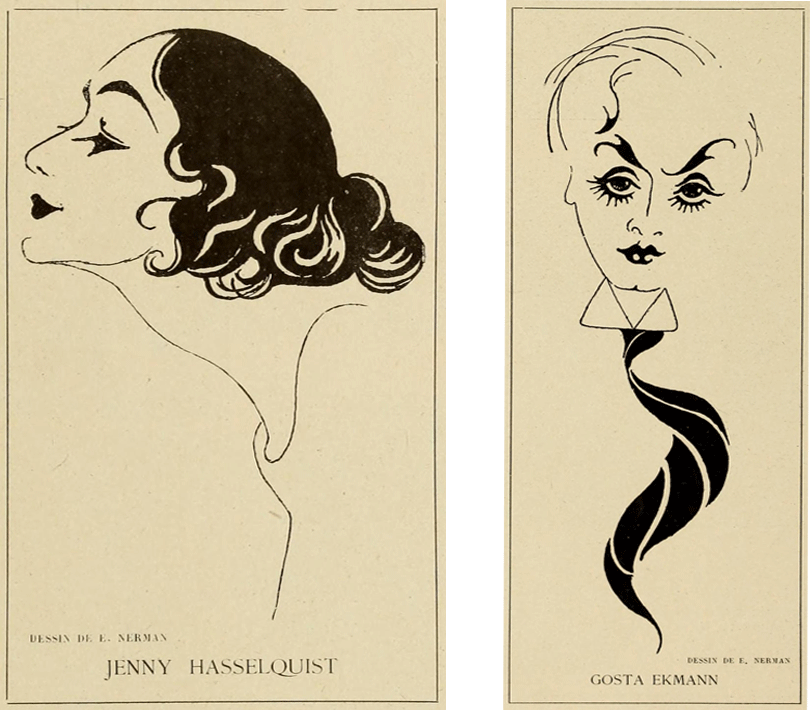
In the United States, then, New York was still very much the barometer for cultural success, in spite of the film industry’s move West. The New York Times opined in 1922 that “in view of the substantial work they have done, the Swedish picture makers seem to have been rather carelessly neglected by Broadway,” noting that New York may see Vem dömer soon, because of the praise it received upon its premiere in London and because The Phantom Carriage had recently paved the way (playing three weeks at the Criterion Theatre) (Anon. 4, 1922: 3). Historically and academically, however, the critical and financial success of The Phantom Carriage has achieved the opposite, pushing Vem dömerinto relative obscurity; it doesn’t help that Ingmar Bergman quoted The Phantom Carriage to have been a major influence on his work (Bergman 1994: 24), but the trained eye will see that Bergman might have learned and borrowed a thing or two from Vem dömer as well. The film continues to occupy a somewhat unfortunate space in Sjöström’s career, after the international success of The Phantom Carriage, right before his move to Hollywood, and generally perceived to be an attempt to “repeat the commercial export success of” Sjöström’s other religious period drama, Klostret i Sendomir (The Monastery of Sendomir; 1920) (Florin 2012: 23).
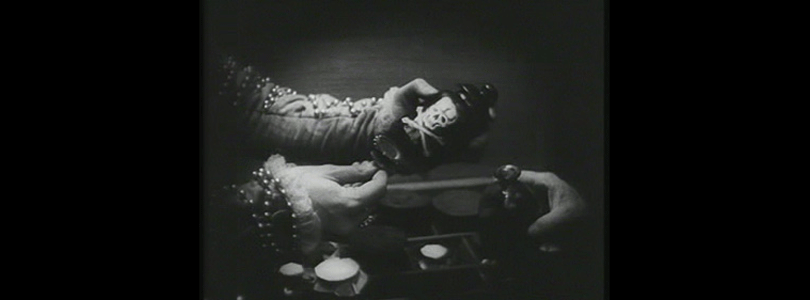
Indeed, the plot and setting of the two films are rather alike: both deal with a marriage between an older man and a younger woman that is violently broken off due to an affair with a younger man; the films share an emphasis on religion and morality; and The Monastery of Sendomi ’s seventeenth-century Gothic Warsawian sets and costumes are not unlike Vem dömer’s fifteenth-century Florence. The story for the film came from an original script by Sjöström’s close friend and famed novelist and playwright, Hjalmar Bergman, who joined him in Hollywood in 1923 to work for Goldwyn; Bergman mocked Sjöström for changing his name to “Seastrom,” jesting that he’d call himself “the Duke of Florence” (Linder 1972: 49). The plot revolves around a noble young lady named Ursula (Jenny Hasselqvist) who is forced to marry the older sculptor Master Anton (Ivan Hedqvist) but is in love with the mayor’s son, Bertram (Gösta Ekman). The clandestine love between Ursula and Bertram is kept alive in the form of a shared book of poems, stolen glances on balconies, and secret meetings, but they are soon found out. Consumed by hatred of her husband, Ursula decides to buy poison from a monk in what he perceives to be a Romeo-and-Juliet type of suicide pact with her lover, and so the monk replaces the poison – elegantly transported inside of a ring - with an innocuous powder (figure 5) and alerts the mayor. This sets off an angry mob that storms Ursula’s house with torches. When her husband tries to confront her, he becomes unwell, and when he sees that Ursula is about to poison him, he dies of a heart attack. Ursula is now tasked with proving her innocence, but it is only through repentance and a test of fire that she is able to convince the community of her innocence and come clean with her own intentions.
Art, Artist, Idol
Variety saw the film as a masterpiece “from a stage manager’s point of view,” as every little detail was worked out, noting that Swedish Bio would do for the film world what the productions of Hare, Alexander, and Irving had done for the legitimate stage (Gore 1922: 33). The National Board of Review’s Frances Taylor Patterson (who started teaching screenwriting at Columbia University in the late 1920s) concurred, lauding the “splendid composition [...], incomparable loveliness of its lighting scenes, [and] architectural magnificence” (Patterson 1922: 4). Vem dömer’s connection to the art of the legitimate stage went beyond the aforementioned analogy, however, for the National Board of Review also played an important part in its introduction into the American market by partnering with the cinema component of the Little Theatre movement (Little Theatre Films, Inc.).
The Little Theatre movement was a progressive national idea that grew from amateur theatres’ dissatisfaction with the lurid melodramas and commercialism of the professional circuit, organizing themselves in the 1910s around dramatists such as Percy MacKaye and associating with the art theatre movement and the wave of modernist forms coming out of Europe (Wilmeth 1996: 309) that Kenneth Macgowan so eloquently dubbed New Stagecraft. As such, these smaller theatre groups were modernist, anti-commercial, and inspired by the loftier institutions such as the Moscow Art Theatre, the Freie Bühne, and the Théâtre Libre, and recognized dramatists such as Edward Gordon Craig, Max Reinhardt, and Adolphe Appia – from it came, for instance, Eugene O’Neill’s Provincetown Players (Chansky 2004: 4). While The Little Theatre movement’s interest in Vem dömer might seem like a trivial distribution matter from the outset, it was actuality an integral part of America’s film history; after the First World War, American production and distribution companies were struck with the popularity and artistic nature of the fare that was coming out of countries such as Germany, Sweden, and Denmark, and started importing films and their staff (save for Sjöström and Stiller, the most notable directors were Ernst Lubitsch, F.W. Murnau, Paul Leni, and Benjamin Christensen) as a way to “lend a touch of class” to Hollywood (Fischer 2009: 7). In essence this was a second (or third) wave of Art films meant to legitimize the cinema as an independent art form, but the European directors’ welcome was worn out towards the end of the 1920s, as they had to fight both the executives who invited them to produce their vision, as well as the critics who made “artistic” ring synonymous with “arrogant” (Petrie 2002: 21).
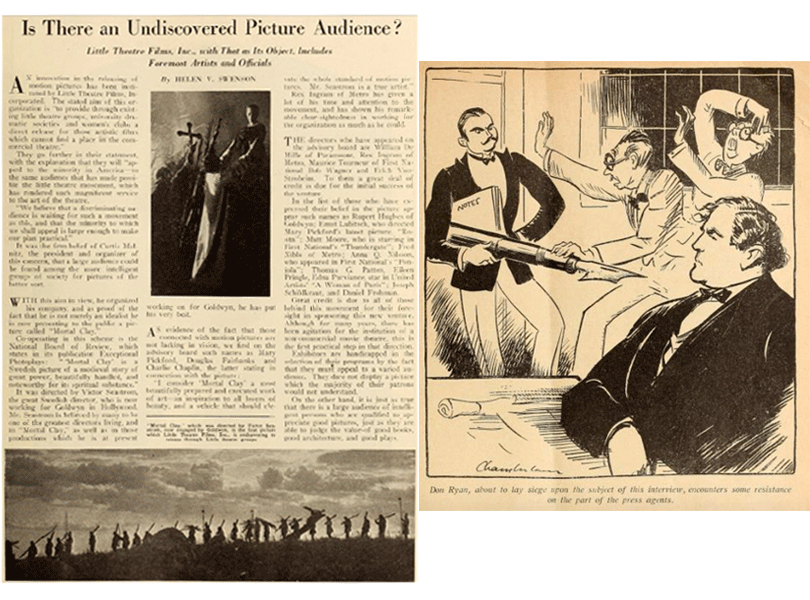
Though film production companies had many times sought out collaborations and associations with the stage in pursuit of “Art” with a capital “A,” the Little Theatre movement’s decision to consider the medium of film a part of its artistic mission was exceptional and marks one of the only times, I believe, that this ever happened (figure 6). According to its president, Curtis Melnitz, this had everything to do with the fact that there was a shared and “discriminating audience [...] waiting for such a movement as this” (Melnitz 1923: 1031) that had already sustained the Little Theatre movement, and an advisory board consisting of, among other notables, Maurice Tourneur, Rex Ingram, Erich von Stroheim, Mary Pickford, Douglas Fairbanks and Charlie Chaplin, chose Vem dömeras its first of twenty five pictures; Sjöström became a member of that advisory board before the film’s release (Anon. 5, 1923: 379). Guzman (2005: 265) has noted that Little Theatre Films never really got off the ground – as opposed to its stage-bound parent company – and has argued that Vem dömer was a sensible and inexpensive choice because American distributors had first passed on it in 1922, before the news that Sjöström was being brought over to Hollywood by Goldwyn had broken. The actual release and follow up to Vem dömer might be a testament to this, as it was noted to appear on screens in the final week of June 1923 (Anon. 6, 1923: 154), but in January 1924 the Little Theatre Films, Inc. president quit (Anon. 7, 1924: 24). Charlie Chaplin, at least, considered Vem dömer to be:
...a most beautifully prepared and executed work of art – an inspiration to all lovers of beauty, and a vehicle that should elevate the whole standard of motion pictures. Mr. Seastrom is a true artist. (Chaplin 1923: 1031).
On top of the promotion (and distribution) of Vem dömer as a work of art, the trade journals also characterized Sjöström as a mythical and aloof European artist, almost to the point of caricature. Described as a strong, tall man with “Nordic blue” eyes, “the blue of the winter sea,” and prophesied to be “the greatest director in motion pictures” (Littlefield 1923: 83), the director is also portrayed as difficult to interview on several occasions (figure 7), with one reporter eloquently describing him to be a man who performs “entrechats of irony before a back-drop of impenetrable gloom” (Ryan 1924: 23).
The characterization and, to a certain degree, antagonization of the figure of the artist is mirrored in Vem dömer’s sculptor, Master Anton (figure 8). The forced marriage that Ursula undergoes in effect subjugates her to him, underscoring the literal meaning of his title “Master.” As Felleman notes, this is a reiteration of the “ancient and mythic scenario of genius and muse, of master and subject,” and, one might add, of artist and model, performed by the usual “couple of older man and younger woman” (2006: 157). It comes as no surprise, then, that Anton’s first act of married life is to substantiate that subjugation by turning Ursula into his model, clearly without her consent (figure 9). She is posed on her knees on a wooden pedestal, looking straight ahead with her hands in a praying position, clad in lace and pearls and wearing a tall crown. Ursula’s pose is that of the popular religious Renaissance motif of the Virgin in Prayer, and more specifically the Coronation of the Virgin, which was highly popular in thirteenth-century Italy (Zirpolo 2009: 110). Ursula’s statuary equation with the Virgin Mary – the most portrayed holy figure – also places her on a metaphoric pedestal as the “good woman,” as an ideal woman full of virtue (Grössinger 1997: 20). When she starts to falter in keeping her pose, then, this can be read as a commentary that it is, in fact, her morality that is slipping because she is having an affair as a married woman.
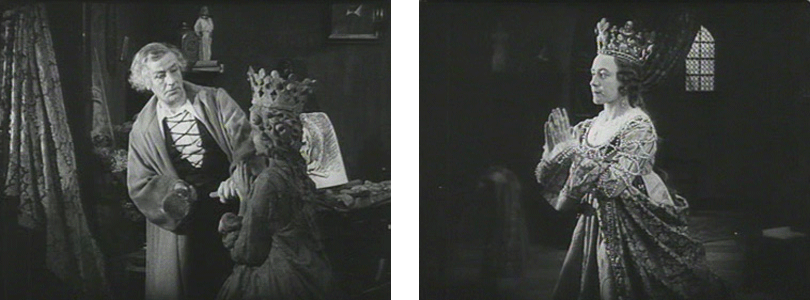
Only Anton’s assistant takes note that she breaks her pose and comes to her aid, as the sculptor seems to be entirely enveloped in his work. He chisels away at her clay double, lovingly caressing its chin at one point, unaware of Ursula’s internal and external struggle. For all the saturnine, hedonistic, and abject qualities ordinarily lent to the character of the artist (Wittkower 2007), however, Anton is not all that bad in Vem dömer. Though the details of the forced marriage are unclear, Anton is otherwise a cuckolded and clueless husband who appears to succumb to a broken heart when he sees that Ursula is trying to poison him with the powder that was initially reserved for her Shakespearian suicide pact with Bertram. Both Ursula’s model pose and Anton’s dying pose are closely tied to the circularity of visual motifs in Vem dömer, a point to which we will return. Ursula’s pose is tied to another religious tale of statuary as well, namely the fourteenth-century Dutch poem Beatrijs(Beatrice; c. 1374), the story of a nun who elopes with a man but whose place in the convent is taken by a statue of the Virgin Mary come to life, preserving her spot and her reputation when she returns down and out 14 years later (van Kerckvoorde 1993: 180). The legend of Beatrice became popular again in the 1910s and 1920s through Karl Volmöller and Max Reinhardt’s play Das Mirakel (1911) and its film adaptation(s) (e.g. Michel Carré’s 1912 The Miracle).
Animated and agitated sculptors and statuary not only made up an important slice of late-nineteenth and early-twentieth century performance culture, but also of early cinema, for instance in the films of Georges Méliès and the Saturn Film Company (Adriaensens & Jacobs 2015: 45-47), but also in Scandinavia, for instance in Urban Gad’s Die ewige Nacht (The Eternal Night; 1916), with Asta Nielsen as a blind model, and in Robert Dinesen’s Djævelens Datter (The Devil’s Daughter; 1913) and Den sidste Nat (The Last Night; 1915) (Adriaensens 2017: 181). This includes Marian apparitions, such as in Le Noël de Monsieur le curé (The Parish Priest’s Christmas; Alice Guy, 1906), but for Ursula, however, statuary magic does not come from the Virgin Mary, in spite of the overt references, but from a statue of Christ Crucified (figure 10) that bookends the film.
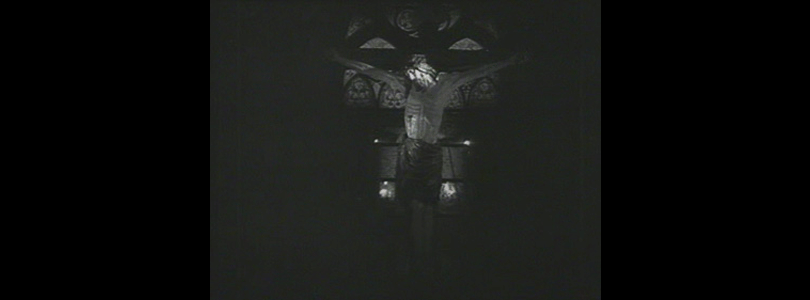
The statue of Christ adorns the local church and is the first and last thing we see in the film. Christ is pivotal for the narrative and for the title, as “Vem dömer” literally translates to “who judges,” implicating that only Christ can, not the community that tries to judge Ursula. The statue thus comments on the actions of the female protagonist and judges her morality, but it does so not merely by being bookended. In the beginning of the film, Ursula prays for deliverance from her marriage in the form of death. The statue delivers what Ursula prays for, but not in the form of her death but that of Anton’s. Even when the monk that sold Ursula the false poison testifies that she could not have killed him, however, there is a severe distrust in the community. The statue of Christ reacts by bleeding from its crown of thorns while the sculptor’s two assistants mourn by his casket (figure 11). This community perceives this miracle as a sign of Ursula’s guilt and so they wield torches to her house (figure 12), screaming to “Burn the Witch!” (figure 13). Bertram decides to take her place when she refuses the bishop’s proposition of proving her innocence through a “trial by fire,” but she realizes the gravity of what she was going to do to Anton and takes Bertram’s place at the stake at the last minute. The statue of Christ Crucified is set up outside by the stake and transforms into Anton’s ghost before Ursula’s eyes (figure 14), guiding her through the fire (figure 15) and vindicating her in front of everyone’s eyes.
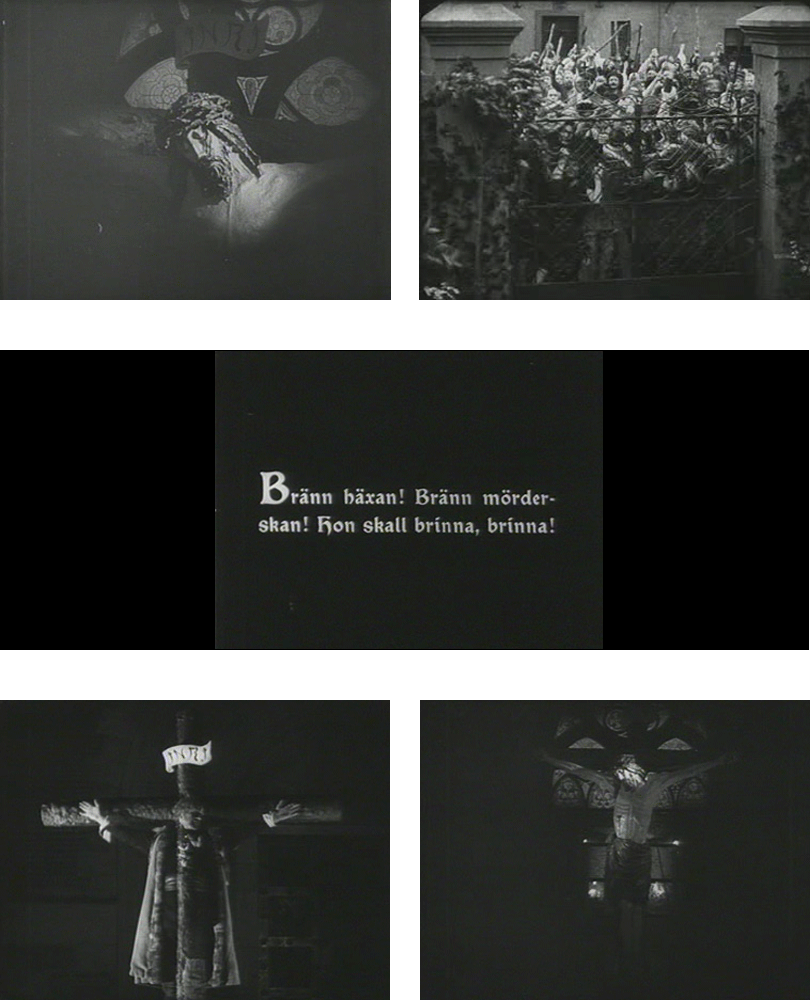
Sjöström’s intent visualization of the statue of Christ Crucified in combination with its powers and Ursula’s dependence on it lead to a fetishization and idolization of Christ Crucified that did not sit well with American critics, who also perceived Ursula’s vindication as unjust. A critic for Variety saw it in London and contacted the censors to question them about this, feeling that the story was without a moral – the murderer is reunited with her lover, after all – and being surprised that the “scenes of the [Sacred] Image, such as the wounds bleeding until the guilty poisoner had expiated his or her sin, were passed” (Gore 1922: 33). The censor replied that he did not object to the “figure of Christ in itself but only to His impersonation by an actor” (O’Connor 1922: 33). As Milne put it, while this resolution seems to be a religious one it is striking that the film refuses to “dissociate the flesh and the spirit in its symbolism” (Milne 1978: 15). It is quite possible that the film was recut for these reasons when it was released in the United States, and this is supported by two ads that freelance editor Lesley Mason took out to boast about his work on Mortal Clay (Mason 1, 1922: 3; Mason 2, 1923: 124). Furthermore, Pictures and the Picturegoer also noted that Vem dömer had undergone a metamorphosis:
In Sweden, the heroine was a murderess – in America she became an innocent young thing wrongfully accused, and the sun made a halo of her vindicated curls before the final ‘fade-out.’ Consequently, as this picture was distinguished by qualities that were altered beyond recognition in America, that country wanted the producer (Anon. 8, 1925: 46).
If Sjöström had not experienced the practice of his films being recut for foreign markets first hand, he was about to. The production of his first American feature for Goldwyn was an adaptation of Hall Caine’s 1921 bestseller The Master of Man: The Story of Sin, again a female-centered story of crime and redemption, adapted as Name the Man (1924) with Mae Busch and Conrad Nagel. As Forslund notes (1988: 183), the production started off with a screenplay that was too long and ended up being cut down from Sjöström’s filmed 12 acts to 8, but nevertheless the film was a huge hit.
Circular Frames and Passionate Tableaux
The presence of Anton’s ghost in the narrative would not have come as a surprise to those familiar with the work of Sjöström, or Swedish culture more broadly, which had been dominated by the supernatural stories of Nobel Prize winning Selma Lagerlöf, and a lot of them echo throughout Hjalmar Bergman’s Vem dömer script. Svenska Bio had bought the rights to all of Lagerlöf’s work prior to 1919 (Soila 1998: 160) and started adapting her work in 1917, leading to such haunting films as, for instance, Ingmarssönerna (Dawn of Love; Victor Sjöström, 1919), which deals with an arranged marriage and consultations with the deceased in heaven; Herr Arnes Pengar (Sir Arne’s Treasure; Mauritz Stiller, 1919), filled with ghosts, omens, curses, and the “hand of God;” and, of course, The Phantom Carriage, in which souls are collected and ghosts haunt past, present, and future.
In all of these films, ghosts are manifestations of lives lost; of characters that were first alive and then shuffled their mortal coils. The visualization of these specters through masterful superimpositions was certainly a major part of why these films were lauded critically, and many of them saw the cinema as the medium to represent the supernatural; in 1923, Ricciotto Canudo argued, for instance, that “cinema permits, and must further develop, the extraordinary and striking faculty of representing immateriality” (2015: 6). This emphasis on past lives in the aforementioned work of Lagerlöf made the author turn to flashbacks that thoroughly shaped the structure of the stories, and these structures were consequently adapted to film; we see them in Ingmarssönerna and Sir Arne’s Treasure, and in The Phantom Carriage we even get flashbacks within flashbacks that were found to be “curiously original in construction” (Bollman 1921: 20). The Monastery of Sendomir, adapted from a story by Franz Grillparzer, is also shaped by flashbacks. Georges Sadoul has stated that Sjöström and Jaenzon’s advanced visualization of flashbacks and spectral imagery was still being discussed in Paris around 1945 as an example to aspire to (Forslund 1988: 53).
Vem dömer’s structure is similarly haunted, but instead of flashbacks it is crafted into a circle on a visual and narrative level, effectuating repetition and reenactment through visual motifs, superimpositions, and cross-dissolves. According to Turim, in The Phantom Carriage, the “memory of the past links the supernatural, the morality tale, and the dream state” (1989: 96), and the same can be said of Vem dömer, although the dream state corresponds more with a vexation on past events that makes Ursula have visions and perform reenactments. The most prominent circularity to the story is, of course, the aforementioned bookending by the statue of Christ Crucified. What is more, we find Ursula praying to the statue both in the opening scene, going into the church alone to pray for her deliverance through death, and in the final scene, thankful for her vindication after the trial by fire. Both her pose (kneeling, praying, staring intently ahead) and that of the crucified Christ (upright and arms splayed wide open) are performed and reenacted multiple times throughout the narrative.
The wedding scene that follows holds the first instance in which both poses are mirrored: when Anton wants to go in for a hug after their marriage is officiated, he opens his arms wide and artificially slows down his actions to create a tableau, moving ever so slightly closer to Ursula, who is looking at him and holding her hands together (figure 16). Though perhaps a subtle gesture, the iris-out to black is followed by an iris-in to Christ Crucified, unmistakably shot in the same position and from the same perspective (figure 17). This reciprocation of Anton’s pose in statuary form is not just a visual motif, but also a foreshadowing of the metamorphosis that the Christ Crucified statue will undergo as it turns into Anton’s specter in the end. Sjöström unfolds this even further in the following shot, when we see that Anton is working on the sculpture of Ursula in her praying position (i.e. Coronation of the Virgin motif), quite literally molding her into this pose (cf. figures 7-8).
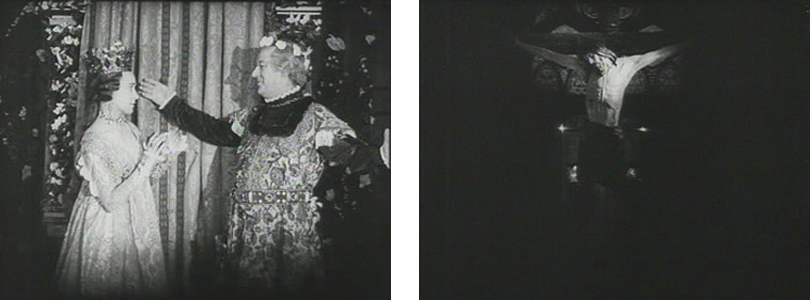
Just as Ursula is forced into her submissive pose by way of a clay proxy, Anton is forced into his pose by Ursula’s affair with Bertram. When Ursula is meeting with her love interest, the sculptor seems to have a premonition that this is going on as Sjöström crosscuts between the two actions. Sweating profusely, Anton grabs at his heart and leans on the statue, but when his two assistants grab hold of him he pushes them away and holds his arms wide open for a few seconds (figure 18). The sculptor looks to have suffered a stroke and, significantly, this is also how he will die. When Anton goes back to the house after learning that Ursula and Bertram have a suicide pact, he first tries to strangle Ursula and then gain entry to the room that Bertram is in. Ursula bars the door with her arms splayed wide (figure 19), assuming Anton’s pose in an image that also featured in the advertising for the film (figure 20). The pose forces Anton back as he grabs his heart again, stumbling to grab onto a mantle in front of a mirror. He asks Ursula for water, but he spies in the mirror that she is poisoning his drink with the (harmless) powder that the monk has given her. In an almost supernatural fashion, invisible forces seem to drive Anton’s arms open and force him back against the wall (figure 21). A single light illuminates the sculptor’s face and torso in the same way that the statue of Christ Crucified is lit, the camera pushes forward to a medium close up as we watch the life drain out of his eyes.
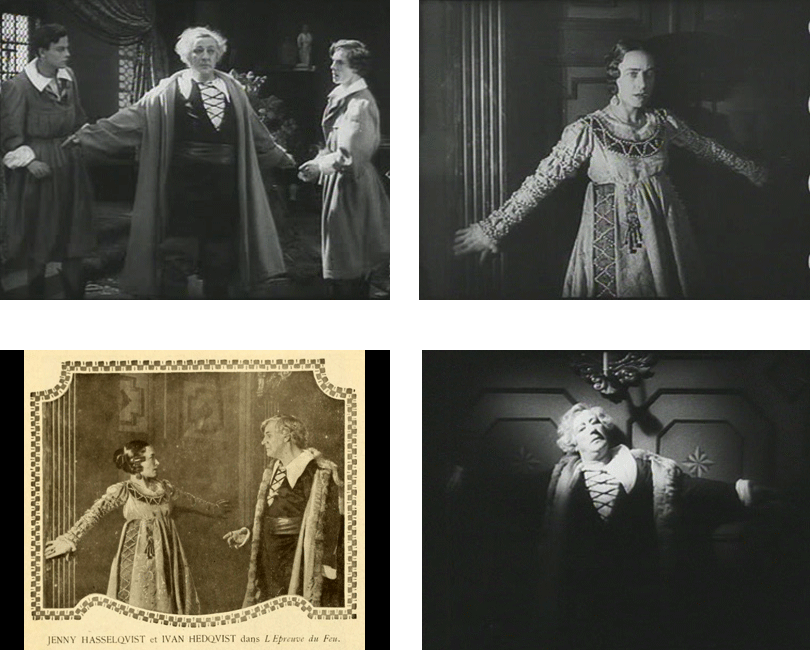
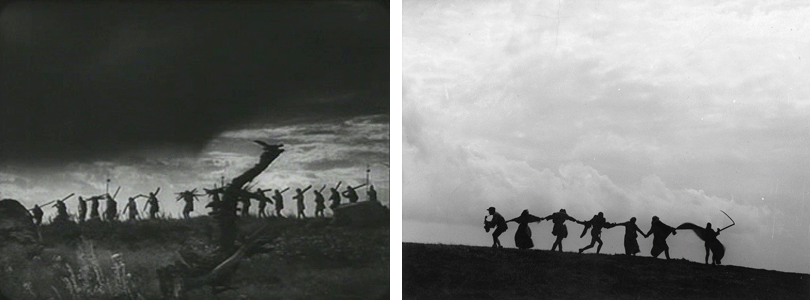
Between Bertram’s arrest and his imminent demise at the stake, Sjöström crosscuts between the community coming together to build the stake in an impressively pictorial sequence (figure 22) that no doubt inspired Ingmar Bergman for his famous horizon scene in Det sjunde inseglet (The Seventh Seal; 1957 – figure 23), and Ursula and the monk isolated in the room Anton died in, trying to piece together what happened, reenacting it in the process. Taking a step back, it is important to frame Anton’s visual equation with Christ’s death as a reenactment in and of itself. As Moss has noted (2010: 65), the bodily and cultic reenactment of Christ at the cross dates back to the reign of Marcus Aurelius, including in the liturgical codification of a pose known as “Orans” (figure 24). In the Middle Ages and the Renaissance, then, the Passion of the Christ became an important part of performance culture through Passion Plays and tableaux vivants (Nijsten 1997: 107-144). Anton seems compelled to take on the Orans posture when dying, Ursula reenacts it to come to terms with her responsibility for his death. When she takes on his final pose, Ursula commands Anton’s specter and literally loses herself for a few beats through a slow lap dissolve (figure 25). It is not until she is standing at the mirror and sees the monk pouring a glass of water that she realizes that Anton saw her mixing in the supposed poison (figure 26). This realization of her implicit responsibility triggers a sincere emotional reaction that compels her to take on Anton’s final pose with the same intensity, lighting, and push in from the camera (figure 27). The next time we see Ursula she has shown up on the stake as a mythical figure, silhouetted in contre-jour surrounded by fire and smoke (figure 28), where she is guided through the fire by Christ in the form of Anton’s ghost (cf. figures 14-15) and closes out the film in her kneeling position by the statue of Christ Crucified (figure 29).
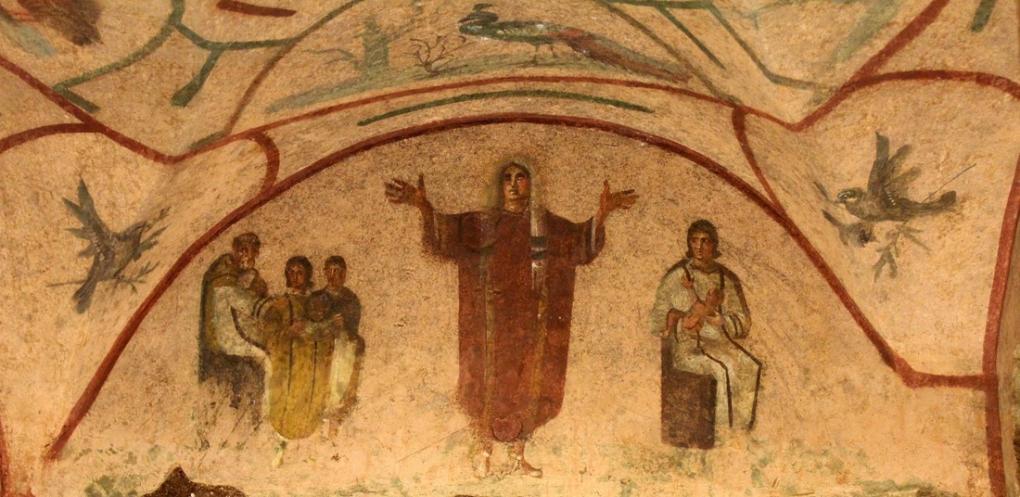

Old Masters Anew: a Scandinavian Dissolve
Sjöström was clearly well versed in the subject matter and iconography of Vem dömer’s Renaissance setting. In its scenography and cinematography, too, the picture seeks to reference and rejuvenate the “Old Masters.” In doing so, Sjöström built on the European tradition of Pictorialist filmmaking that was established in the 1910s and in which Scandinavia had a big stake alongside France and Italy. This “tableau style,” as Bordwell (2006: 80-95) has called it, was effectuated by “Netherlandish” images that were composed of chiaroscuro “Rembrandt” lighting and a long-take mise-en-scène that employed deep staging and aperture framing and has been analyzed before in this journal (Adriaensens 2015).
Contemporary film journals likewise invoked the Old Masters to speak about the medium of film as an art, most often referring to Rembrandt, Rubens, and Velázquez, betraying a predilection for seventeenth-century artists that must have played in the minds of filmmakers as well. As journalist Marjorie Mayne noted it in 1924, Sjöström and his fellow directors undoubtedly went to museums for their inspiration:
It is certain that the Old Masters inspire the New. For composition, for lighting effects, for draperies, costumes and types, [they] translate what they find into celluloid, using their own medium of light and shade [...]. [T]he best of them hail from the Old World: Seastrom, Stroheim, Ingram, Lubitsch, Gance, Pearson (41). [...] And the director went to the picture galleries for his data. Victor Seastrom re-incarnated Renaissance art in Love’s Crucible, scene after scene of which remains an unforgettable memory (44).
Viewing Vem dömer as if it were a living painting is indeed an effective strategy for analyzing the film, as indeed by extension for European tableau cinema of the 1910s and 1920s. As Hollander has noted in her analysis of seventeenth-century Dutch art, artists such as Jan Vermeer, Pieter de Hooch, Rembrandt and Nicolaes Maes “ingenuously manipulated the space within their pictures” by creating different areas for their figures to inhabit; these scenes-within-scenes were introduced by devices such as “archways, open doors, pulled-back curtains [...] or appear within the frames of mirrors and pictures on walls” (2002: 1-2). This “entrance for the eyes,” as Hollander has called it, became a formula that banked heavily on the use of perspective, depth and aperture framing in interiors by the middle of the century, also integrating religious allegories into secular spaces (2002: 3). A marvelous example of this is Pieter de Hooch’s Een stel wandelt door het Stadhuis van Amsterdam (A Couple Walking in the Citizens' Hall of Amsterdam Town Hall; c. 1663-1665) (figure 30).
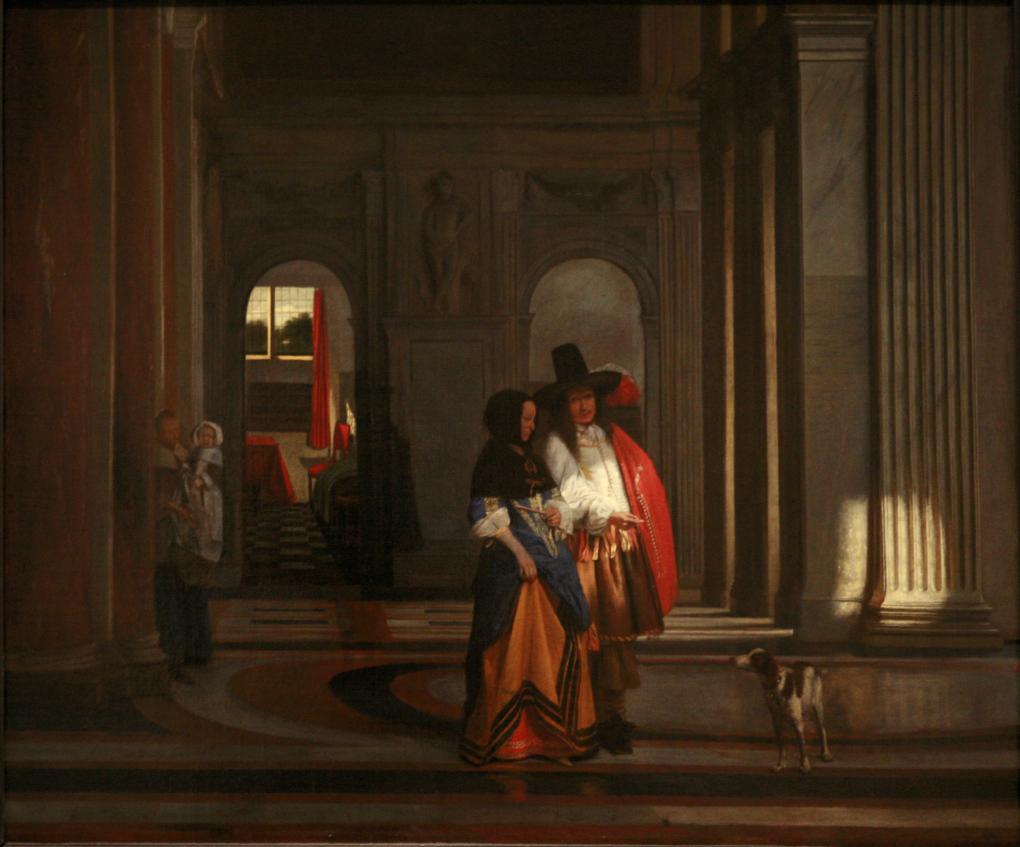
One scene in Vem dömer where this approach is formidably illustrated sees Bertram moping on a street corner after being told by his father, the mayor, that he is not to see Ursula any more. Posited on the foreground, Bertram and the right wall of the street corner act as a repoussoir that create extra depth in the left side of the frame. The left side of the frame is further subdivided into a middle ground and a deep background: on the far left is the middle ground that holds a torch and a door, and to its right we find an arch that frames the action in the deep background (figure 31). Interestingly, when Sjöström cuts closer on the axis as his father comes by to offer some consoling words, we see that the two actresses in the deep background are deliberately frozen to effectuate a tableau vivant (figure 32). They resume their action only after Anton has joined the conversation in the foreground, dismissing Bertram with a wave of his hand and walking off and away through the arch with his friend, the mayor, trading places with the monk who will sell Ursula the fake poison (figure 33). The camera tilts down slightly to reframe the action when the monk reaches the foreground and the lighting once again emphasizes the different frames-in-frames and zones of depth in Sjöström’s composition (figure 34).
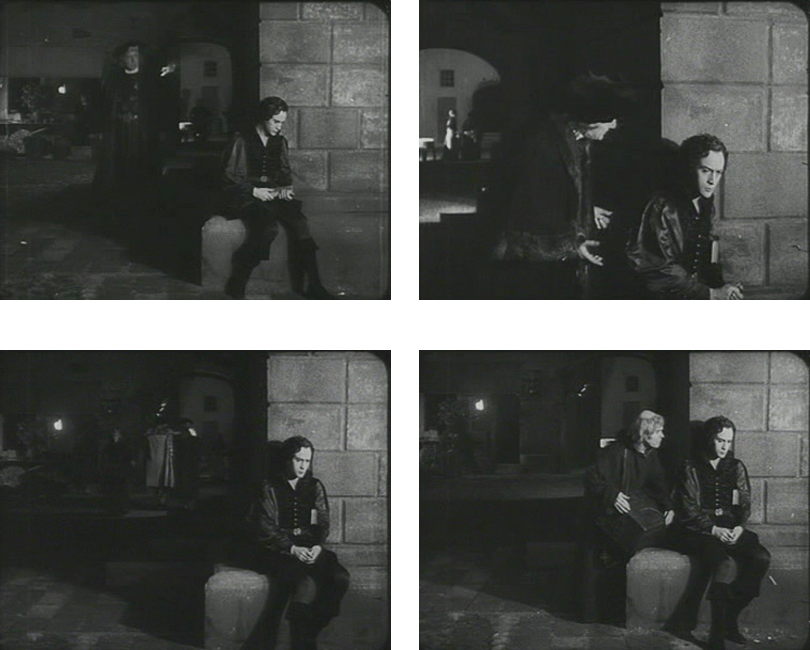
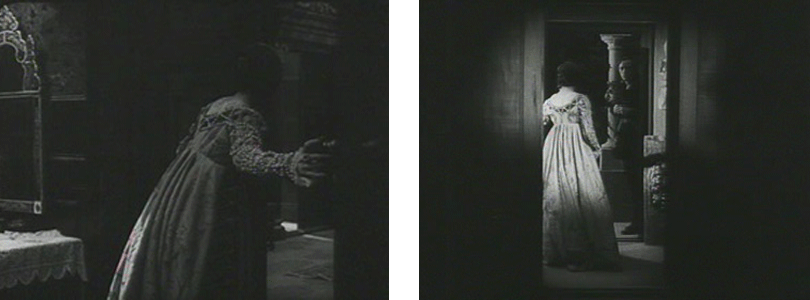
This is far from the only scene that is played out in this referential way, as can be evidenced, for instance: in the deep focus composition with aperture framing that sees the monk leaving Ursula’s room after his sale (figure 35) and Ursula letting Bertram in that same room but from another door (figure 36), as compared to, for instance, Nicolaes Maes’s curtained trompe l’loeuil Afluisterend dienstmeisje naast een half weggeschoven gordijn (Eavesdropper with a Scolding Woman; c. 1655) (figure 37) and Samuel van Hoogstraten’s De Pantoffels (The Slippers; 1660) (figure 38); and On the whole, as Söderbergh Widding has already noted, Swedish and Danish cinema had a predilection for using scenic space and frame-in-frame devices in interesting ways in the silent period (1999: 187-203).

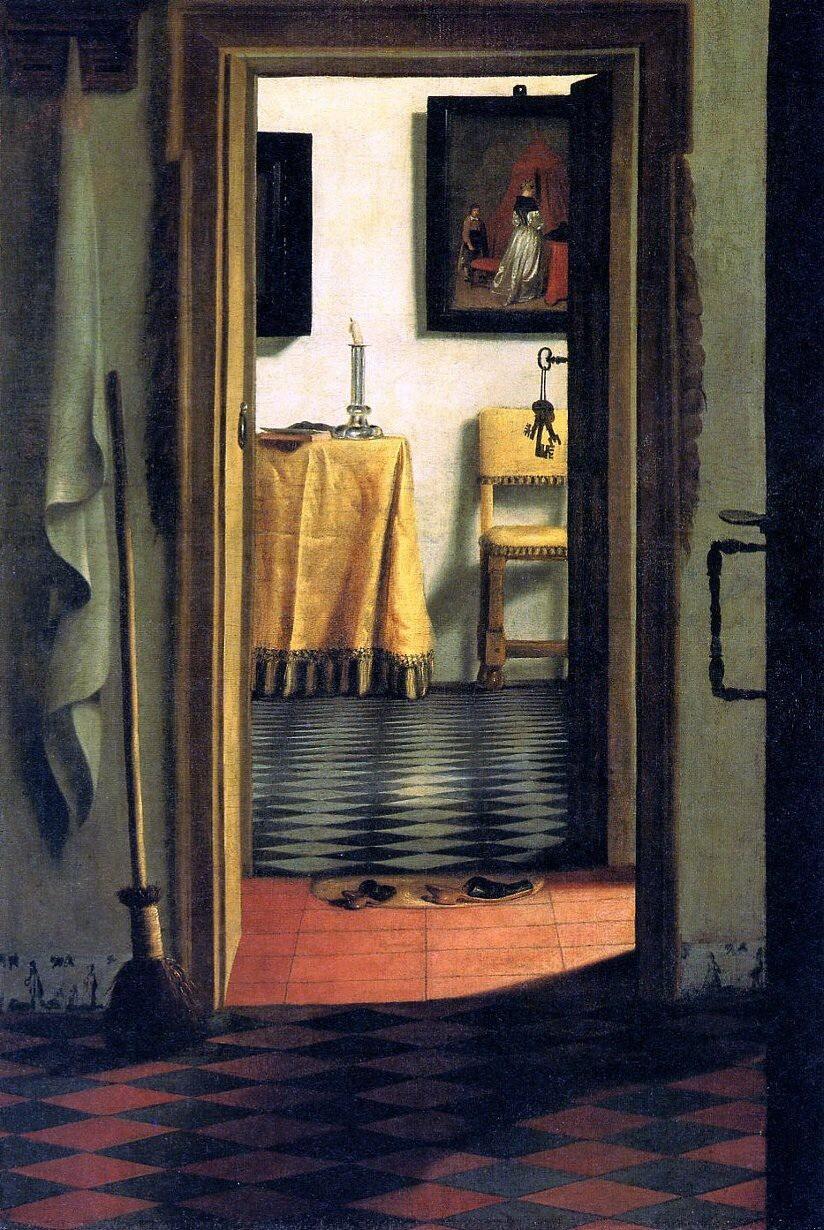
As a final note to stimulate further research, I would like to point to Sjöström and his cinematographer Julius Jaenzon’s (or J. Julius) use of the cross-dissolve as a scene transition in Vem dömer, which Florin has called “transformatory devices” (2012: 21). I propose we start calling this effect the “Scandinavian dissolve” in honor of the Swedish and Danish directors such as Sjöström, Stiller, and Dreyer that seemed to have pioneered and perfected this particular brand of deliberately delayed dissolve from the late 1910s throughout the 1920s, fading out in the sound era. These Scandinavian dissolves work as complements to the subdivision of the frame, rather doubling up to create exquisitely composed frames-on-frames that generate a spectral iconography that is highly particular and in tune with modernist modes of photography. In Vem dömer, Sjöström technically uses Scandinavian dissolves to move further or closer on the axis, to create shot/reverse shots, or to replace hard cuts, but their real power lies in the systematic nature with which they make Ursula spectrally haunt every frame (figures 39-42).
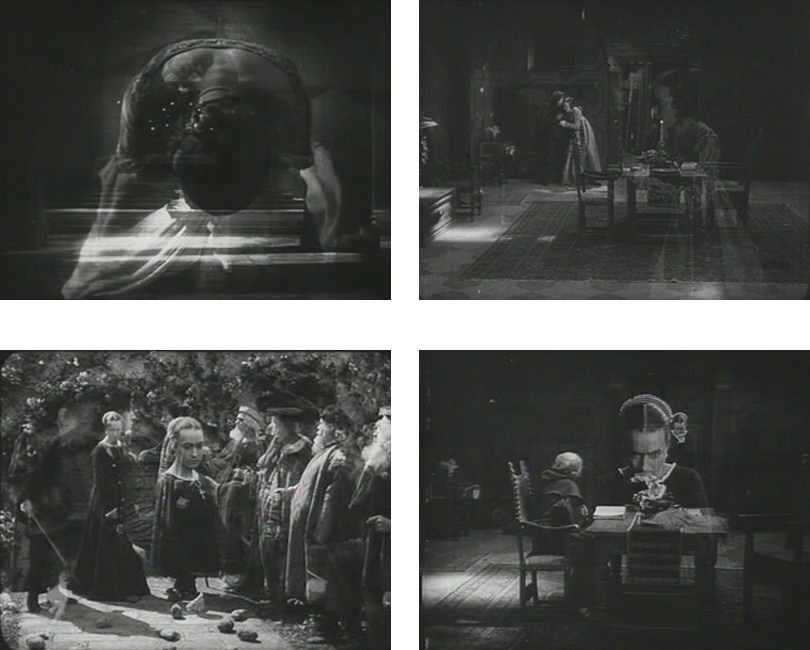
BY: VITO ADRIAENSENS / VISITING SCHOLAR AND ADJUNCT ASSISTANT PROFESSOR, COLUMBIA UNIVERSITY/ RESEARCHER, UNIVERSITY OF ANTWERP
Notes
1. AB Svenska Biografteatern operated from 1907 until 1919, when it merged with Filmindustri AB Skandia and became Svensk Filmindustri AB. To the outside world, the company would remain known as Swedish Biograph. Charles Magnusson continued to run the company until 1928, and it still exists today.
References
Adriaensens, Vito (2015). “‘Kunst og Kino’: The Art of Early Danish Drama.” Kosmorama 259.
Adriaensens, Vito (2017). “Die ewige Nacht” in Jacobs, Steven, Susan Felleman, Vito Adriaensens, and Lisa Colpaert. Screening Statues: Sculpture and Cinema. Edinburgh: Edinburgh University Press, 2017, p. 181.
Adriaensens, Vito & Steven Jacobs (2015). “The Sculptor’s Dream: Tableaux Vivants and Living Statues in the Films of Méliès and Saturn.” Early Popular Visual Culture vol. 13 no. 1 (2015), pp. 41-65.
Anon. 1 (1919). “Reids and Rawlinsons of Sweden.” Photoplay vol. XVII no.1 (December 1919), p.32.
Anon. 2 (1921). “Les Merveilles du Cinéma Suédois.” Cinéa no. XI exceptionnel (15 July 1921), cover. Author’s translation.
Anon. 3 (1921). “Les Films Suédois à Revoir et à Voir.” Cinéa no. XI exceptionnel (15 July 1921), p. 5.
Anon. 4 (1922). “Picture Plays and People.” The New York Times vol. LXXI no. 23,549 (16 July 1922), p. 3.
Anon. 5 (1923). “Organization of Little Theatre: Advisory Board Completed with Addition of Several Names.” Exhibitors Trade Review vol. 14 no. 9 (28 July 1923), p. 379.
Anon. 6 (1923). “Little Theatre’s Initial Picture.” Exhibitors Trade Review vol. 14 no. 4 (23 June 1923), p. 154.
Anon. 7 (1924). “Curtis Melnitz Quits Little Theatre Films.” Exhibitors Herald vol. XVIII no. 3 (12 January 1924), p. 24.
Anon. 8 (1925). “The Sombreness of Seastrom.” Pictures and the Picturegoer vol. 10 no. 57 (September 1925), p. 46.
Bergman, Ingmar & Marianne Ruuth (transl.) (1994). Images: My Life in Film. New York: Arcade Publishing.
Bollman, Gladys (1921). “Reviews of Films.” Educational Film Magazine vol. V no. 4 (April 1921), pp. 20-23.
Bordwell, David (2006). “Nordisk and the Tableau Aesthetic” in Richter Larsen, Lisbeth & Dan Nissen (eds.). 100 Years of Nordisk Film. Copenhagen: Danish Film Institute, pp. 80-95.
Canudo, Ricciotto (2015) quoted in Leeder, Murray (ed.). Cinematic Ghosts: Haunting and Spectrality from Silent Cinema to the Digital Era. New York and London: Bloomsbury, p. 6.
Chamberlain, K.R (1924). “Don Ryan, about to lay siege upon the subject of this interview, encounters some resistance on the part of the press agents.” Picture-Play Magazine vol. XX no. 1 (March 1924), p. 23.
Chansky, Dorothy (2004). Composing Ourselves: The Little Theatre Movement and the American Audience. Carbondale: Southern Illinois University Press.
Chaplin, Charles (1923) quoted in Swenson, Helen V. (1923). “Is There an Undiscovered Picture Audience?” Exhibitors Trade Review vol. 14 no. 23 (3 November 1923), p. 1031.
Felleman, Susan (2006). Art in the Cinematic Imagination. Austin: University of Texas Press.
Fischer, Lucy (ed.). (2009). American Cinema of the 1920s: Themes and Variations. New Brunswick and London: Rutgers University Press.
Florin, Bo (2012). Transition and Transformation: Victor Sjöström in Hollywood 1923-1930. Amsterdam: Amsterdam University Press.
Forslund, Bengt and Peter Cowie (transl.) (1988). Victor Sjöström: His Life and His Work. New York: Zoetrope.
Fullerton, John (2005). “Svenska Biografteatern” in Abel, Richard (ed.), Encyclopedia of Early Cinema. London and New York: Routledge, pp. 890-891.
Gore (1922). “Love’s Crucible.” Variety vol. LXVII no. 6 (30 June 1922), p. 33.
Griffith, Linda A. (1919). “Comments and Criticisms of a Free-Lance.” Film Fun vol. 31 no. 363 (July 1919), pp. 6-7.
Grössinger, Christa (1997). Picturing Women in Late Medieval and Renaissance Art. Manchester and New York: Manchester University Press.
Guzman, Tony (2005). “The Little Theatre Movement: The Institutionalization of the European Art Film in America.” Film History: An International Journal vol. 17 no. 2/3 (2005), pp. 261-284.
Hollander, Martha (2002). An Entrance for the Eyes: Space and Meaning in Seventeenth-Century Dutch Art. Berkeley, Los Angeles, and London: University of California Press.
Landry, Lionel (1922). “L’Epreuve du Feu.” Cinéa vol. II no. 81 (15 December 1922), p.16.
Linder, Erik Hj. & Marna Feldt and Carmen Sandström-Smith (transl.) (1972). “Hjalmar Bergman in Hollywood: A Sad Chapter” in Wessell, Nils Y. (ed.). The American-Swedish ’72. Philadelphia: American Swedish Historical Foundation, pp. 45-62.
Littlefield, Constance Palmer (1923). “New Hope for the American Photoplay: Victor Seastrom Talks about Our Motion Pictures.” Screenland vol. VIII no. 1 (October 1923), pp. 62-63 & 83.
Marklund, Anders (2010). “The Golden Age and Late Silent Cinema: Introduction” in Larsson, Mariah & Anders Marklund (eds.), Swedish Film: An Introduction and Reader. Lund: Nordic Academic Press, pp. 72-75.
Mason 1, Lesley (1922). “‘Mortal Clay’ Will Be The Talk of the Season.” The Film Daily vol. XXI no. 78 (18 September 1922), p. 3.
Mason 2, Lesley (1923). “Don’t Take MY Word for It!” in Dannenberg, Joseph (ed.). Film Year Book 1922-1923. New York and Hollywood: Wid’s Films and Film Folks, Inc., p.124.
Mayne, Marjorie (1924). “The New Masters.” Pictures and the Picturegoer vol. 7 no. 37 (January 1924), pp. 41-44
Melnitz, Curtis (1923) quoted in Swenson, Helen V. (1923). “Is There an Undiscovered Picture Audience?” Exhibitors Trade Review vol. 14 no. 23 (3 November 1923), p. 1031.
Milne, Tom (1978). “Vem dömer? (Love’s Crucible).” Monthly Film Bulletin vol. 45 no. 528 (January 1978), p. 15.
Moss, Candida R. (2010). The Other Christs: Imitating Jesus in Ancient Christian Ideologies of Martyrdom. Oxford and New York: Oxford University Press.
Nerman, E. (1921). “Gosta Ekmann [sic].” Cinéa no. XI exceptionnel (15 July 1921), p. 10.
Nerman, E. (1921). “Jenny Hasselquist [sic].” Cinéa no. XI exceptionnel (15 July 1921), p. 7.
Nerman, E. (1921). “Victor Sjostrom [sic].” Cinéa no. XI exceptionnel (15 July 1921), p. 21.
Nijsten, Gerard (1997). “Feasts and Public Spectacle: Late Medieval Drama and Performance in the Low Countries” in Knight, Alan. E. (ed). The Stage as Mirror: Civic Theatre in Late Medieval Europe. Cambridge: D.S. Brewer, pp. 107-144.
O’Connor, T.P. quoted in Gore (1922). “Love’s Crucible.” Variety vol. LXVII no. 6 (30 June 1922), p. 33.
Patterson, Frances Taylor (1922). “The Swedish Photoplays.” Exceptional Photoplays vol. III no. 2 (December 1922), pp. 3-4.
Petrie, Graham (2002). Hollywood Destinies: European Directors in America, 1922-1931 (Revised Edition). Detroit: Wayne State University Press.
R.L.C. (1921). “Victor Sjostrom [sic].” Cinéa no. XI exceptionnel (15 July 1921), p. 21. Author’s translation.
Ryan, Don (1924). “Entrechats of Irony: A somewhat futile attempt to interview Victor Seastrom.” Picture-Play Magazine vol. XX no. 1 (March 1924), pp. 22-24 & 108.
Soila, Tytti (1998). “Sweden” in Soila, Tytti, Astrid Söderbergh Widding, and Gunnar Iversen. Nordic National Cinemas. London and New York: Routledge, pp. 142-233.
Söderbergh Widding, Astrid (1999). “Towards Classical Narration? Georg af Klercker in Context” in Fullerton, John and Jan Olsson (eds.). Nordic Explorations: Film Before 1930. Sydney: John Libbey, pp. 187-203.
Turim, Maureen (1989). Flashbacks in Film: Memory & History. New York and London: Routledge.
van Kerckvoorde, Colette M. (1993). An Introduction to Middle Dutch. Berlin and New York: Mouton de Gruyter.
Wilmeth, Don. B. (1996). “1865-1915” in Witham, Barry B. (ed.), Theatre in the United States: A Documentary History. Volume I: 1750-1915 – Theatre in the Colonies and United States. Cambridge and New York: Cambridge University Press, pp. 169-313.
Wittkower, Margot and Rudolf (2007). Born Under Saturn: The Character and Conduct of Artists – A Documented History from Antiquity to the French Revolution. New York: New York Review of Books.
Zirpolo, Lilian H. (2009). The A to Z of Renaissance Art. Lanham, Toronto, and Plymouth: The Scarecrow Press, Inc.
Suggested citation
Adriaensens, Vito (2017): A Swedish Renaissance: Art and Passion in Victor Sjöström’s "Vem dömer" (1922). Kosmorama #269 (www.kosmorama.org).
